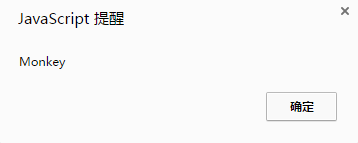script、image、iframe的src都不受同源策略的影響。所以我們可以藉助這一特點,實現跨域。如前面所介紹的JSONP跨域,以及燈標(Beacons)。該篇隨筆主要闡述iframe結合一些技術,實現跨域請求。1、iframe+window.name;2、iframe+location.ha... ...
script、image、iframe的src都不受同源策略的影響。所以我們可以藉助這一特點,實現跨域。如前面所介紹的JSONP跨域,以及燈標(Beacons)。
該篇隨筆主要闡述iframe結合一些技術,實現跨域請求。
1、iframe+window.name;
2、iframe+location.hash;
3、iframe+window.postMessage.
另,在最後賦予“燈標”技術闡述。
| 一、iframe + window.name實現跨域 |
window對象有個name屬性,該屬性有個牛逼的地方就是:在同一個視窗中,我不管你頁面怎麼變,我window.name的值是一直存在的,在同一個視窗任意讀寫,並且支持非常長的name值(2MB)。
有點含糊?
我們寫個demo看看。
假設我有個頁面a.html,當頁面載入完成後,我將window.name賦值’Monkey’,在3秒後跳轉到另一頁面b.html,併在這個b.html中alert一下window.name,看看結果如何。
a.html代碼如下:
<!DOCTYPE html> <head> <title>window.name</title> <meta http-equiv="Content-Type" content="text/html; charset=utf-8"/> </head> <body> <script> window.name = 'Monkey'; setTimeout(function(){ window.location = 'b.html'; },3000); </script> </body> </html>
b.html代碼如下:
<!DOCTYPE html> <head> <title>window.name</title> <meta http-equiv="Content-Type" content="text/html; charset=utf-8"/> </head> <body> <script> alert(window.name); </script> </body> </html>
運行a.html代碼,等待3秒後,得如下結果:

看來,只要在同一個視窗,window.name就是可讀寫的,如,前一個頁面設置了這個屬性,後一個頁面就可以讀取它。
註:window.name傳輸技術,原本是用於解決cookie的一些劣勢(每個功能變數名稱4*20KB的限制、數據只能是字元串、設置和獲取cookie語法的複雜等等)而發明,後來才強化了window.name傳輸,用來解決跨域數據傳輸問題。
假設,當我在一個頁面a中想跨域訪問另一個不在同一域中b的數據時,怎麼利用window.name呢?
顯然,我們不能像上面那樣,將a頁面window.location重定向為b,這樣我豈不是當前頁面已經不再了。所以我們可以藉助於iframe標簽來達到這一目的(因為iframe的src不受同源策略影響,所以可以跨域訪問資源)。
思路:
(1)、在a.html中嵌入iframe,將所需要的文檔b.html載入進來,且b.html利用window.name傳入a.html想要獲取的數據;
(2)、iframe在得到b.html的內容後,必須將src變為a.html的同源域,因為同源策略是會阻止非同源的frame訪問name屬性值,最後a.html通過iframe.contentWindow.name,獲取b.html里window.name的值,從而實現跨域獲得數據。
demo如下:

<!DOCTYPE html> <head> <title>a.html</title> <meta http-equiv="Content-Type" content="text/html; charset=utf-8"/> </head> <body> <script> /* addIframeTag:動態創建iframe,通過src獲得相應文檔 Param: src -->動態給創建iframe的src賦值 */ function addIframeTag(src){ //在loadFn函數中,用於判斷iframe載入情況 var state = 0; //創建iframe var iframe = document.createElement('iframe'); //loadFn:跨域獲取數據,如b.html var loadFn = function(){ if (state === 1) { //獲取window.name數據 var data = iframe.contentWindow.name; //相關操作,如alert獲取的數據 alert(data); //清除動態創建的iframe iframe.contentWindow.document.write(''); iframe.contentWindow.close(); document.body.removeChild(iframe); } else if (state === 0) { state = 1; // 將src變為a.html的同源域 iframe.src = "a.html"; } }; //給創建的iframe賦予指定的src值 iframe.src = src; //當iframe載入完文件後,觸發onload事件 if (iframe.attachEvent) { iframe.attachEvent('onload', loadFn); } else { iframe.onload = loadFn; } //隱藏iframe iframe.style.display = 'none'; //將創建的iframe加入body中 document.body.appendChild(iframe); }; window.onload = function(){ addIframeTag('b.html'); }; </script> </body> </html>a.html

<!DOCTYPE html> <head> <title>b.html</title> <meta http-equiv="Content-Type" content="text/html; charset=utf-8"/> </head> <body> <script> window.name = 'Monkey'; </script> </body> </html>b.html
| 二、iframe + location.hash實現跨域 |
location.hash簡而言之就是錨點,如127.0.0.1#monkey中的#monkey就是錨點。借用大額的一個例子,具體感受下錨點:here。
大家點擊了上面的例子,會發現點擊錨點後location.hash改變了,但卻沒有導致頁面刷新。
So,我們就可以藉助這一特性,實現數據傳遞。 但,因為我是藉助於location.hash來實現數據傳遞,所以缺點也很明顯:數據是直接暴露在URL中,且傳遞的數據容量有限。
那麼,我們怎麼通過location.hash來實現跨域訪問數據呢?
假設:a.html想跨域訪問b.html中的數據
思路:因為改變a.html的location.hash值不會刷新頁面,所以我們可以藉助iframe去訪問b.html(因為iframe的src不受同源策略影響,所以可以跨域訪問資源),然後在iframe中動態改變它父視窗a.html中的location.hash值。但是,個別瀏覽器不允許非同源的視窗修改parent.location.hash的值,所以我們還需要藉助一個代理,在iframe獲得b.html後,再在iframe里嵌套一個與a.html同源的html,如c.html,並通過c.html中的parent.parent.location.hash改變a.html中的location.hash值,從而達到跨域獲取數據。

拋磚引玉,我的具體實現如下:
註:由於我是在本地跑的程式,所以我將c.html 直接換成a.html,並加入錨點判斷,只是為了體驗一把iframe+location.hash的跨域。

<!DOCTYPE html> <head> <title>a.html</title> <meta http-equiv="Content-Type" content="text/html; charset=utf-8"/> </head> <body> <script> function startRequest(){ //獲得a.html的錨點 var _hash = location.hash ? location.hash.substring(1):''; //如果錨點是b.html中的代理ifrmae傳來的,則賦值,如somedata if(_hash === 'proxy'){ parent.parent.location.hash = 'somedata'; return; } else{ //創建一個iframe var ifr = document.createElement('iframe'); ifr.style.display = 'none'; //想b.html獲取信息 ifr.src = 'b.html#paramdo'; document.body.appendChild(ifr); //獲得b.html的數據 setInterval(function(){ try{ var data = location.hash ? location.hash.substring(1):''; if(console.log){ console.log('Now data is '+ data); } }catch(e){ console.log(e); } },2000); } }; startRequest(); </script> </body> </html>a.html

<!DOCTYPE html> <head> <title>b.html</title> <meta http-equiv="Content-Type" content="text/html; charset=utf-8"/> </head> <body> <script> //如果發現傳過來的location.hash是#paramdo,做callBack操作 if(location.hash === '#paramdo'){ callBack(); } function callBack(){ try{ parent.location.hash = 'somedata'; }catch(e){ // ie、chrome的安全機制無法修改parent.location.hash, // 所以要利用一個代理iframe,src與a.html同源 var ifrproxy = document.createElement('iframe'); ifrproxy.style.display = 'none'; //這裡我指向a.html只是為了模擬同源 ifrproxy.src='a.html#proxy'; document.body.appendChild(ifrproxy); } } </script> </body> </html>b.html
| 三、iframe + window.postMessage實現跨域 |
HTML5引入了一個跨域文檔API(Cross-document messaging),這個API為window對象,新增了個window.postMessage方法,允許跨視窗通信,且不必同源。
語法如下:
otherwindow.postMessage(message, targetOrigin);
(1)、otherwindow:對接收信息頁面的window引用,可以是頁面中iframe的contentWindow屬性;window.open返回值;通過name或下標從window.frames取到的值。
(2)、message:要發送的數據,string類型。
(3)、targetOrigin:用於接收消息的視窗的源(origin),即“協議 + 功能變數名稱 + 埠”。也可以設為*,表示不限制功能變數名稱,向所有視窗發送。
postMessage是向視窗發送信息,當然相應視窗得接收信息咯。
怎麼接收信息呢?
通過message事件,監聽對方的信息。一旦有postMessage傳送過來的信息就可以做相應處理了。
如下:
Window.addEventListener(‘message’,function(e){console.log(e.data);},false);
且message中的e(即event對象),通過三屬性:
(1)、event.source:發送消息的視窗對象;
(2)、event.origin:發送消息視窗的源(協議+主機+埠號);
(3)、event.data:發送的消息內容。
拋磚迎玉Demo(a.html與b.html通信)如下:

<!DOCTYPE html> <head> <title>a.html</title> <meta http-equiv="Content-Type" content="text/html; charset=utf-8"/> </head> <body> <iframe id="ifr" src='b.html'></iframe> <script> window.onload = function(){ var ifr = document.getElementById('ifr'); ifr.contentWindow.postMessage('I was there','/'); }; </script> </body> </html>a.html

<!DOCTYPE html> <head> <title>b.html</title> <meta http-equiv="Content-Type" content="text/html; charset=utf-8"/> </head> <body> <script> window.addEventListener('message', function(event){ console.log('origin: '+event.origin); console.log('data: '+event.data); console.log('source'+event.source); }); </script> </body> </html>b.html
運行上述a.html代碼,得下:

| 四、拓展--燈標 |
此技術與動態iframe標簽插入非常類似,用JavaScript創建一個新的Image對象,將src設置為伺服器上一個腳本文件的URL。此URL包含我們打算通過GET格式傳回的鍵值對數據。
註意並沒有創建img元素或者將它們插入到DOM中。
如下:
var url = '/status_tracker.php'; var params = [ 'step = 2', 'time = 1465141496244' ]; (new Image()).src = url + '?' + params.join('&');
伺服器取得此數據並保存下來,而不必向客戶端返回什麼,因此沒有實際的圖像顯示。這是將信息發回伺服器最有效的方法。其開銷很小,而且任何伺服器端錯誤都不會影響客戶端。
簡單的圖像燈標意味著你所能做的受到限制。你不能發送POST數據,所以你被URL長度限制在一個相當小的字元數量上。你可以用非常有限的方法接收返回數據。可以監聽Image對象的load事件,它可以告訴你伺服器端是否成功接收了數據,你還可以檢查伺服器返回圖片的寬度和高度(如果返回了一張圖片)並用這些數字通知你伺服器的狀態。例如,寬度為1表示‘成功’,2表示‘重試’。
如果你不需要為此響應返回數據,那麼你應當發送一個204 No Content響應代碼,無消息正文。它將阻止客服端繼續等待永遠不會到來的消息體:
var url = '/status_tracker.php'; var params = [ 'step = 2', 'time = 1465141496244' ]; var beacon = new Image(); beacon.src = url + '?' + params.join('&'); beacon.onload = function(){ if(this.width == 1){ //Success }else if(this.width == 2){ //Failure;create another beacon and try again. } } beacon.onerror = function(){ //Error;wait a bit, then create another beacon and try again. }
燈標是向伺服器回送數據最快和最有效的方法。伺服器根本不需要發回任何響應正文,所以你不必擔心客戶端下載數據。唯一的缺點是接收到的響應類型是受限的。如果你需要向客戶端返回大量數據,那麼使用XHR。如果你只關心將數據發送到服務端(可能需要極少的回覆),那麼使用圖像燈標。
| 五、參考文獻 |
[1]、大額
[2]、無雙
[3]、RainMan
[4]、MDN
[5]、阮一峰




